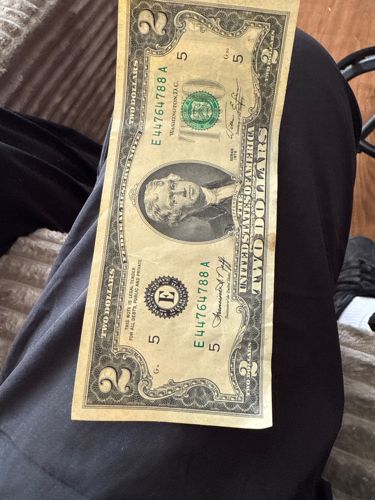Two-Dollar Bill
Country of Origin: United States of America
Year of Issue: Series 1976 (based on the visible cues like the red seal usually associated with this series' reintroduction)
Denomination: Two Dollars
Composition: 75% cotton, 25% linen

Brief Description
The obverse features a portrait of Thomas Jefferson with the words "TWO DOLLARS" on the left and right borders. The serial number E44764788 A is visible, along with the Federal Reserve Bank seal for District E (Richmond). The reverse (not visible in the image) typically depicts the signing of the Declaration of Independence.
Historical Significance
The two-dollar bill has a rich history, though it's less common in circulation than other denominations. It was first issued in 1862 and re-designed in 1976 to feature Thomas Jefferson on the obverse and the Trumbull painting of the signing of the Declaration of Independence on the reverse. Its relative rarity in everyday transactions has led to some misconceptions about its value or legality, though it is legal tender. The 1976 series was intended to increase its usage as part of the bicentennial celebration.
Estimated Value
For a circulated 1976 series two-dollar bill, the value is typically its face value, which is $2. Uncirculated or special circumstances (like star notes or very early printings in pristine condition) might fetch a slight premium, usually not more than $3-$5.
Care Instructions
Handle with clean, dry hands, preferably by the edges, to avoid transferring oils and dirt from your skin. Store flat in a protective sleeve or album designed for paper currency to prevent folds, creases, tears, and environmental damage. Keep away from direct sunlight, extreme temperatures, and high humidity.
Created At: 2025-10-29T19:08:32.784251